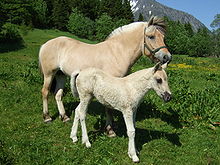Horse trade

Horse trading is the buying and selling of horses.
Today, a purchase inspection is recommended when buying a horse . Unless otherwise agreed, the legal regulations apply when buying horses by handshake, but handshake contracts are prone to misunderstandings.
history
The horse was the most valuable animal in agriculture, it was worth around four cows. Much was at stake in the horse trade. That is why in Norway, in the 13th century in Frostathingslov, the guarantee for the purchase of horses was set. Nevertheless, Amund Helland wrote that in the horse trade, unlike other businesses, there was no shame in deceiving the other party. For this reason, some horse traders were considered to be rustlers . The age of a horse can be estimated with the help of the teeth . This is where the saying "You don't look in the mouth of a given horse" comes from.
Disputes in connection with the horse trade have been documented many times in court files since the Middle Ages.
In Germany, in order to protect buyers and sellers, the deficiencies in warranties were laid down in the Imperial Ordinance on Main Defects and Warranty Periods in Cattle Trade of March 27, 1899 and the BGB . If a warranty defect became apparent within 14 days of purchase, the buyer could request that the purchase be reversed.
Horse trade in Norway
The Norwegian census of 1900 lists around 240 professional horse dealers. Horses were bred in western Norway and sold to eastern Norway and Sweden. In western Norway it was cheaper to breed horses than in the east due to suitable pastureland. There, on the other hand, the need for work horses for forestry , agriculture and transport was great, but horse breeding was less profitable.
Especially Sogn og Fjordane and Møre og Romsdal were known for their horse breeding. Young horses were usually bought by horse traders when they were four years old and brought east.
The horse traders mostly lived in western Norway, between the horse breeding villages and the markets in eastern Norway, and had to have some capital. In the spring they went for a round and bought young horses, the horses were picked up and spent the summer in the pastures in the high mountains before they were brought to the market or sold on the way. Horses from Vestland , which are to be sold in autumn at the Kongsberg market or in Rauland , often grazed on the Hardangervidda over the summer . Some horses have been brought for sale as far as Sweden and northern Norway. Until the end of the 20th century, horses were herded from Lærdal and Nordfjord over the mountains to the markets in eastern Norway. Many horses were traded across the border at the basic set market and the Levanger market.
There were horse markets in Oslo, from 1640 in Kristiania and from 1736 in Stortorvet, until the 1960s. In Kristiania, 500 horses were for sale at the horse market of February 1885. In 1940 there were 17 horse markets and 42 horse races in Norway. In 1940 the horse market in Levanger took place twice. The most valuable horses were advertised in newspaper advertisements.
See also
Individual evidence
- ^ Hardangervidda , Verlag Grøndahl, Oslo 1979
- ↑ Geographical entry to folketellingen 1900 i søkbar (and skanna) form i digitalarkivet
- ↑ Fjordhesten i Norge, Arne M. Bekken, 1986
- ↑ Olaf A. Lwefdal - Mitt liv med hester fjord, Jarle Hammer, 1986
- ^ Norges land og folk: topografisk-statistisk beskrevet: topografisk-statistisk beskrivelse over , Verlag Aschehoug, Kristiania 1913
- ↑ Hesten var nødvendig , Nils Jarman, publishing I kommisjon hos Landbruksforlaget, Oslo 1989, ISBN 8252913911
